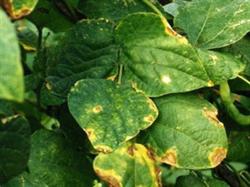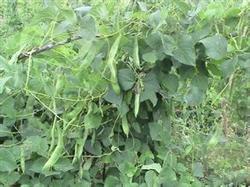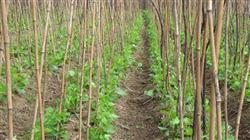Greenhouse tomato with kidney bean

1. High-quality and high-yield techniques of tomato in winter and spring. 1. Selection of improved varieties. The Mawa tomato cultivated by Rexwan Company of the Netherlands is selected. This variety belongs to infinite growth type, medium maturity, good yield, flat round fruit, bright red, good coloring, good taste, medium and large fruit, uniform fruit, good fruit weight of 200-230 grams, good firmness and resistance to storage and transportation. it is very popular with customers. 2. sow seeds at the right time. The nutritious soil is made of fully rotten farm manure, fully mature farm manure, fully rotten horse manure and 5% soil tunes. According to the local climate characteristics and market factors, the best sowing date is mid-October. The seeding bed is set in the zone where there is plenty of light, making a flat bed with a north-south direction of 4 meters long and 1 meter wide, turning 25 cm deep with a spade, cuddling flat, trampling on flat shoes, spreading nutritious soil 3 cm thick into the seedling bed, scraping it flat with a flat board, pouring through the bottom water, and marking it into a small square of 3 cm × 3 cm with a self-made "printing rake" with a printing depth of 3 cm. Take the dry seed direct seeding, put the seeds in a small square, press the seeds into the soil with your fingers, cover the nutritious soil 1 cm thick, cover with a layer of plastic film to keep warm and moisturize, and sprinkle corn flour with white oil and the poison valley of trichlorfon around the seedbed to prevent pests from eating seedlings. Before emergence, 28-30 ℃ during the day and 18-20 ℃ at night. 6-7 days after sowing, the seedlings emerged and then the plastic film was removed. When the cotyledons flattened 3-4 days after emergence, 72.2% Prik 2000 times solution was sprayed once to prevent and cure the quenching disease. After emergence, 24-26 ℃ in daytime and 13-15 ℃ at night. In order to improve the quality of seedlings and control diseases and insect pests in time, the leaves were sprayed with 300x solution of Magic Zhuang and 2000 times of mites were sprayed on the leaves of Liriomyza huidobrensis. When the seedlings grow to 2 leaves and 1 heart, the seedlings with small soil clods are moved into the seedling bowl (8 cm × 10 cm, nutritious soil is the same as above), placed in the flat border and watered one by one. 3. Seedling stage management. ① temperature: 28-30 ℃ in daytime, 16-18 ℃ at night, 24-26 ℃ in daytime, 13-15 ℃ at night, and the lowest temperature is no less than 10 ℃. ② light, always keep the greenhouse film bright and clean, wipe it once every 5-7 days, brush it once a day, and uncover the grass curtain early and late when the temperature permits. When the seedlings grow until the leaves overlap each other, expand the tuo once, so that the distance between the seedlings can reach 12 cm × 12 cm. ③ fertilizer and water should be irrigated once every 7 days or so, and then irrigated thoroughly one by one. Foliar spraying 300 times liquid Magic Zhuang twice to improve the quality of seedlings. ④ was used to control diseases and insect pests. 2000-fold solution was sprayed on the leaves of Liriomyza huidobrensis and Kelu on the leaves of late blight. 4. Land preparation and planting. First, remove the remaining branches and leaves of the previous stubble, dig a high-yield ditch with a width of 40 cm and a depth of 30 cm according to the row spacing of 1 meter, spread the fully mature farm manure in the ditch according to the amount of fertilizer applied at a rate of 10,000 kg per mu, turn it over with a spade, mix the soil and fertilizer evenly, cuddle and open the ditch with a depth of 15 cm, planing according to the plant spacing of 30 cm, apply 0.5 kg of humic acid organic fertilizer and 0.3 kg of diammonium phosphate per mu, and mix well with the soil. On December 4, the seedlings with 5 leaves and 1 heart were planted in a single row according to plant spacing and watered thoroughly. After 7 days, the soil was ploughed once, and the soil was flat with Miaotuo. The seedlings were watered slowly about 10 days after planting, and then ploughed every 5-6 days for a total of 5 times. 5. Temperature management after planting. 25-28 ℃ during the day and 13-15 ℃ at night, and the lowest temperature is no less than 10 ℃. The outside of the shed is covered with double-layer grass curtains to strengthen cold protection and heat preservation. When the temperature of the shed rises to 28-30 ℃, the top wind is released, ventilation and humidity are drained, and the temperature is reduced to 22-24 ℃. Keep on letting out for 30-60 minutes at noon in the low temperature season. When the fruit is fully expanded, the night temperature is controlled about 14 ℃ to promote the fruit to turn red. 6. Light management. The greenhouse film should be dusted once in 2-3 days and wiped once in 5-7 days, and it should be kept smooth and clean. under the condition of temperature, the straw curtain should be opened as early as possible, and the straw curtain should be rolled up with a shutter to increase the lighting time. 7. Fertilizer and water management. Always keep the soil moist, slow seedling water with 12 kg of humic acid tomato special fertilizer per mu, and then topdressing the same amount of fertilizer and irrigating small water once every 10-15 days (that is, ridges on both sides of alternately ridging), combined with mid-tillage and planting, it is helpful to improve the soil temperature and cultivate good roots. In the peak period of fruit expansion in the middle of February, Magic Lifeng was applied with water flushing 2 kg per mu, then once every 7-10 days, and applied alternately with 20 kg potassium nitrate compound fertilizer. If biogas slurry is available, it can be applied together until the seedlings are pulled. In order to improve fruit quality, foliar fertilizers such as calcium nitrate and liquid boron were sprayed on the leaves. 8. Plant adjustment. Take single stem pruning, leaving 6 ears of fruit to pick the core, leaving 5-6 per ear, and picking off the lateral branches when they grow to 5-10 cm. After the fruit of each ear is fully expanded, the lower leaves are knocked out and the bottom leaves are hit for 4 times, which is beneficial to ventilation and light transmission. Dipping flowers using CPM tomato harvest element, each plus 1 kg of water spray. 9. Apply carbon dioxide gas fertilizer. In the middle of February, 4-6 bags of carbon dioxide growth aid per mu were applied once every 10 days for 4 times. 10. Pest control. To control bacterial diseases, irrigate the root twice with "Ke Dao 2000" liquid or penicillin plus 45 kg water for 2 times. To control Botrytis cinerea, the wilting yellow petals and fruit needles were removed in time, and 1000 times of Huian solution was sprayed on the leaves, once every 7 days, for 4 times. Leaf mold disease leaves were sprayed with 50% methyl topiramate suspension 600 times, once every 5-7 days, a total of 3 times. Second, interplanting kidney bean cultivation techniques 1. Sowing at the right time. Dalian 923 variety with good commodity quality, high yield and welcomed by the market is selected, and it takes about 50 days from sowing to harvest. When the tomato 1-3 ear fruit was fully expanded and the lower leaves were knocked out, the seeds were sown in mid-late February, and the dry seeds were directly seeded at 10 cm on the side of the tomato planting row. In the middle of every 2 tomatoes, dig 5 cm deep holes with picks, sow 2-3 grains in each hole, and cover the soil 3 cm thick. 2. Reasonable pruning. Kidney beans after emergence, with the tomato watering, ploughing twice, grow to 4-6 leaves when picking the heart, so that its lower long out of the side vine, and in time before or after pulling the vine set a hanging rope (fishnet line) to tie up, so as not to affect the growth of the tomato. Before the final harvest, the field management of tomato is the same as tomato, but in the control of leaf mildew, the solution sprayed on the leaf should not be sprayed on the kidney bean plant as far as possible. After the final harvest, the temperature of tomato was kept at 24-26 ℃ in daytime and 13-15 ℃ at night, mainly against the wind, and often kept the greenhouse film smooth and clean. 3. Other management. With the application of humic acid organic fertilizer 12 kg per mu, about once every 7 days, a total of 8-9 times. In order to prevent falling flowers and pods, increase the ventilation rate, mainly in the face of the wind. When the vine is 2 meters high, pick the heart in time, and then remove the new side vines at the top every 7 days to prevent "running vines". The control method of gray mold is the same as above, whitefly whitefly is sprayed with 3000 times of whitefly Sujing solution, once every 5-7 days, a total of 2-3 times. Kidney beans were harvested in late April and in mid-July.
- Prev

Control of main Diseases and insect pests of Kidney Bean
See the symptoms of melon white silk disease: dark brown at the base of the stem, dense white filamentous mycelium on the surface, and tea-brown round sclerotia on the mycelium in the later stage. Disease regularity and control methods: refer to the distribution of Sclerotinia sclerotiorum disease of melon and host plant: it is distributed all over the country. In addition to harming beans,.
- Next

High yield and High efficiency cultivation of Autumn Kidney Bean
Autumn kidney bean, also known as knife bean and kidney bean, is one of the main autumn vegetables in Dongtai City, Jiangsu Province. It has been popularized and planted in more than 20, 000 mu from 2004 to 2007, with a yield of 1300-1400 kg per mu and an output value of 1800-2200 yuan. In addition to the supply market, the products are mostly used for foreign trade dehydration processing. First, arrange the stubble reasonably. Plant Qiuyun.
Related
- The first cup of black tea in spring, the flavor and history of tea gardens in Kenya, Africa
- The computer can not only choose potatoes, but also grow tea rice. AI will grow winter oolong tea champion.
- It is not only the inflated tea bitten by insects, but also engraved with the four seasons tea in Beipu.
- The Oriental Beauty Tea Festival in Zhuxian County takes the stage at the weekend to experience the plus-size feast of oil tea.
- & quot; Oriental Beauty Tea & Exploration of Emei in Hsinchu, the hometown of quot;
- The new variety of strawberry "Tainong 1" dessert is the first choice with mellow aroma. Crimson gorgeous
- History of Tea in Taiwan: from Wild Inner Mountain to Export Tea Garden
- Two types of Taiwan Oriental Beauty Black Tea won the British three-Star Award for Childhood Tea Xiang Zhang Jiaqi changed from pilot to champion tea maker.
- Banana species and varieties: the planting history of Taiwan Xianren banana and dwarf banana is long, is banana disease resistant?
- Coffee planting Technology: Qianjie Coffee from Seedling to harvesting

